
NPS Photo/Kim Girard The Birds of the Sonoran DesertOrgan Pipe Cactus National Monument sits along a primary migratory flyway and because of this, birding is a popular and fantastic recreational opportunity! More than 270 bird species have been recorded in the monument. The vast majority visit the Organ Pipe Cactus only while migrating, taking advantage of the desert’s seasonal flowers, fruits, and warm winters. There are 36 species of resident birds that can be found throughout Organ Pipe Cactus, from the oasis at Quitobaquito to the cliffs in Arch Canyon. 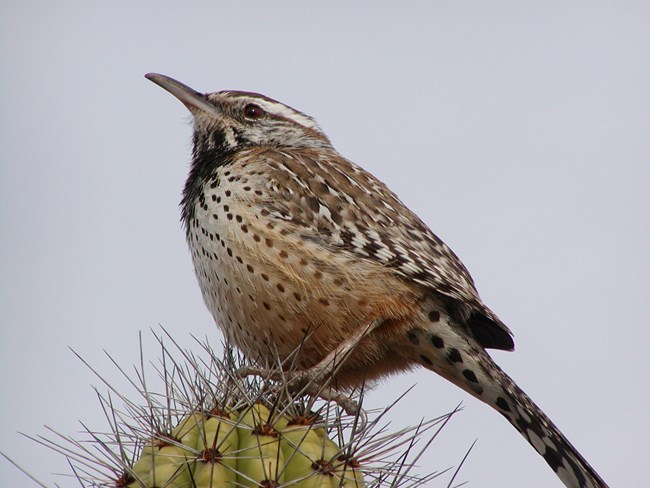
NPS Photo Cactus Wren (Campylorhynchus brunneicapillus)The call of the cactus wren has long symbolized the desert landscape. Cactus wrens make their way through the monument by flitting thorugh creosote scrub and cactus stands, eating fruit, insects, and other small critters. Nests are easy to spot and often at eye level in the branches of chain-fruit cholla, where they are protected by the spiny cactus. Identify this BirdThese large wrens are a little smaller than a robin. Cactus wrens sport a distinct white "eyebrow", and a black patch on the throat. The body plumage is a buff or cinnamon brown with black and white barring. To locate a cactus wren, listen for the sound of an old car trying, and failing, to start. These spunky birds are very common and can often be seen in parking lots picking insects off the front of cars. 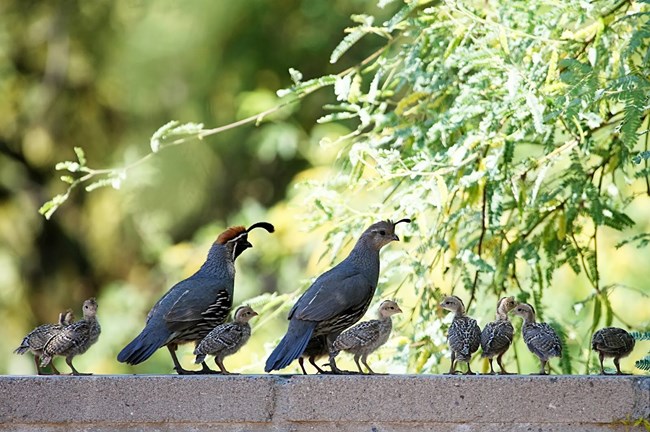
NPS Photo Gambel’s Quail (Callipepla gambelii)Gambel's quail are related to chickens, and they behave similarly, too! Cautiously working their way over the landscape, Gambel's quail forage for seeds and insects on the ground. These very common birds scurry away to maintain distance from predators or birdwatchers, only flying in short, often noisy bursts. Spotting a a group or "covey" of Gambel’s quail is almost a sure bet when strolling Twin Peaks Campground around sunrise or sunset. Identify this BirdTo find Gambel's quail, listen for the conversational “boop-boop? Boop boop-boop boop?” or an occasional “waaa!”. Look out for gray or dusty-brown birds. Males have a chestnut-colored cap and sides, and a dark face with white marks. Both males and females have sandy-colored bellies, and bobbing, tear-drop shaped head feathers, though the males is usually fuller. 
NPS Photo Elf owl (Micrathene whitneyi)The round holes seen in many saguaros may have been originally made by Gila woodpeckers or flickers but are often adopted by elf owls once once the architect leaves. This tiny owl is only 4.5-5.5 inches long (11.5-14 cm)and eats mostly insects and arachnids, though it may occasionally take a small lizard. These owls form groups during the breeding season and harrass or "mob" predators like snakes or foxes that get too close to nests. Identify this OwlThe world's tiniest raptor is rarely seen, as it is only around the monument in the summer, and only active at night. The easiest way to observe one is by listening for their raspy "purp purp-purp-purp-purp purp" calls. If you happen to see one of these elusive owls, you will notice a tiny gray-brown body, distinct white eyebrow, large yellow eyes, maybe peering out from a cactus. 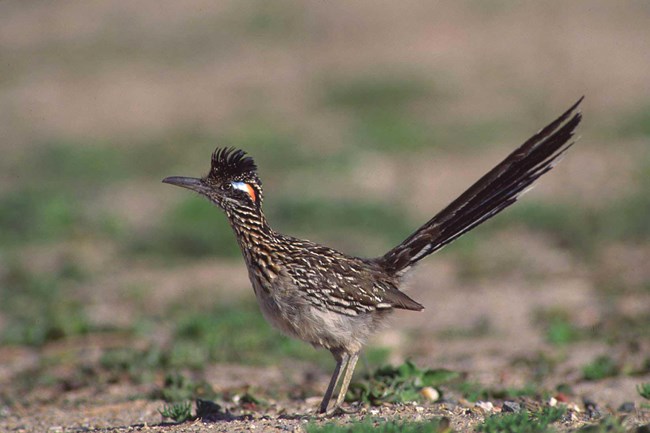
NPS Photo Greater roadrunner (Geococcyx californianus)Roadrunners are fierce hunters of lizards, snakes, insects, small mammals, and even other birds. When hunting, they will grab their target, often by the tail, and thrash their prey against the ground to subdue it. They are agile runners and typically only fly short distances to escape predators or access a nest. This bird is an important figure in many Native American and Mexican stories. Identify this BirdRoadrunners are most often spotted... Running on the road! These crow-sized birds crouch low to the ground when running, with their long tail straight behind them for balance. Their call is a repeating low coo or raspy squeak. The roadrunner's brown feathers are irridescent when the light hits them just right. They have a patch of bare skin behind their eye that is sometimes bright blue and red, and they sport an expressive head crest. 
NPS Photo/Craig Stocks Costa’s hummingbird (Calypte costae)Several species of hummingbird can be found in the national monument. Many plants, such as ocotillo, chuparosa, and California fuchsia, display the tubular red flower form that hummingbirds prefer. Hummingbirds zip through the air, hovering to feed on the nectar of flowers, and occasionally perch to preen their feathers. During the breeding season, males perform spectacular aerial dives to woo females. Identify this BirdMales and female Costa's hummingbirds are bright green, with short tails and slender wings. The bill is fairly heavy and dark. The patch of vibrant feathers or "gorget" that is most noticable on the males is deeply lobed, stretching behind the eyes and sometimes sticking out to the sides from the throat. The gorget is a brilliant violet when the light hits it just right, and almost black in dull light. 
NPS Photo/Jonah Snead Northern cardinal (Cardinalis cardinalis)Cardinals often frequent shady mesquite groves in washes and canyons, and are commonly sighted near the pupfish pond behind the Kris Eggle Visitor Center. These bright singbirds are a common yard bird that is easy to see in many areas of eastern to southern North America Identify this BirdMale cardinals are easily recognized by their bright red color, crest, and striking black mask. Females are a more subtle mix of brown and red and may be mistaken for a similar resident, the pyrrhuloxia. The easiest way to tell a female cardinal and a pyrrhuloxia apart is by the beak; Pyrrhuloxias have a round, yellow bill, while the cardinal posesses a very pointy orange bill. The northern cardinal's song is variable and may contain a steady, repeating "pewr pewr pewr", similar to a car alarm. 
NPS Photo/Jane Gamble Phainopepla (Phainopepla nitens)The main food source of the phainopepla is mistletoe and these birds are largely responsible for the spread of this parasitic plant. These birds are most often spotted perched on the upper branches of mistletoe-infested trees. Phainopeplas have a digestive tract specialized for eating mistletoe berries. The berries are not very nutritious, so the phainopepla constantly eats, and passes seeds onto other trees, creating another food source for the future. Identify this BirdThe phainopepla may look like a jet-black cardinal, but these small berry-eaters are not related to the chunky cardinal. Males are black and females are medium gray, both with large, white wing patches that are only visible in flight. Both sexes have striking red eyes and shiny plumage. Phainopepla are known to mimic the sounds of many other birds, but may also give a "wuURP" call. 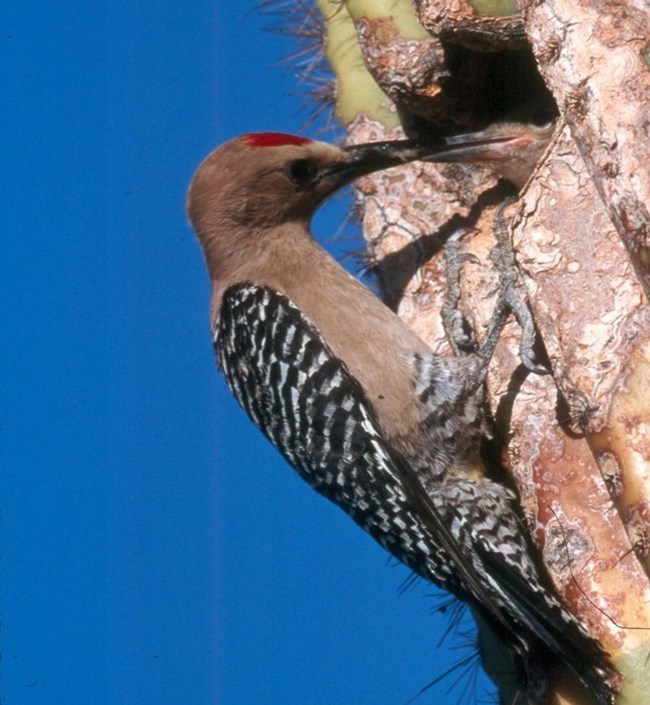
NPS Photo Gila woodpecker (Melanerpes uropygialis)This woodpecker is the cause of many of the nest holes seen in saguaro cacti. During the nesting season, thes birds will peck away the skin and inner flesh of a saguaro and leave the hole until the cactus scabs over. The woodpecker will return to its hollow shelter to nest. Gila woodpeckers don't reuse their holes, so while they create new ones each season, other animals will move into vacant hollows. Identify this BirdSimilar in appearance to the flickers that share part of its range, the Gila woodpecker can be distinguished by the lack of a black bib and the presence a red mark on the crown instead of cheeks. Gila woodpeckers sound a bit like rattling squeaky toys, or can give raspy, evenly spaced squeaks. 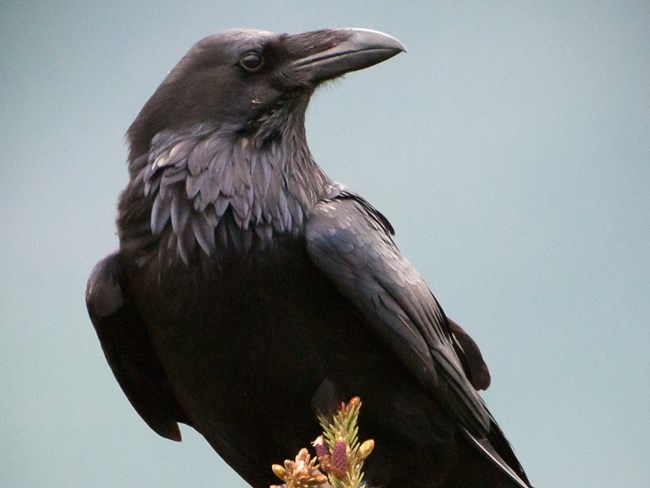
NPS Photo/Kent Miller Common Raven (Corvus Corax)Ravens are highly intelligent birds, known to use tools and adjust behavior to secure snacks. Ravens are also notorious thieves of shiny objects and food, which is a good reason to keep your campsite clean. These large black birds are often mistaken for crows where their ranges overlap, though ravens are the only crow-like birds (corvids) found at Organ Pipe Cactus National Monument. Identify this BirdYou will likely first notice a raven if it flies near you. These birds are quite large (up to twice the size of a crow), with a very large beak and a diamond-shaped tail. Ravens make sounds that are decidedly un-birdlike. They may croak like a toad, emit a metallic “ploink!”, a clicking, wooden “conk”, or mimic whatever odd sound suits their fancy. When relaxing, they may puff up their beard-like throat feathers to help cool off. 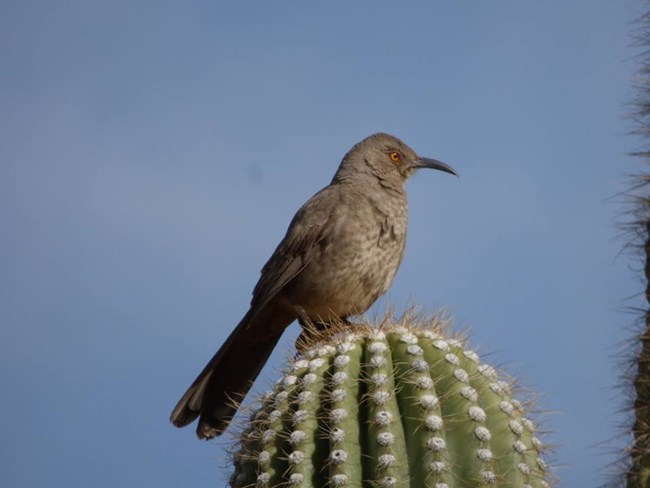
NPS Photo Curve-billed thrasher (Toxostoma curvirostre)Curve-billed thrashers are common to open parking lots, and thorny scrub, hunting for insects and other small prey. They will fly to reliable water sources for hydration. Like the cactus wren, curve-billed thrashers often nest in cholla but tend to use twigs rather than grasses for the main structure. Identify this BirdThe curve-billed thrasher's call is a loud "wheet-WHEET", while its songs are variable and melodious. This bird is about the size of a robin, with a long tail, and long, thick, down-curved bill. The bright orange-yellow eye stands out against the mottled gray body. Bird and Wildlife ChecklistUse the NPSpecies box below to discover what other birds and wildlife are found at Organ Pipe Cactus National Monument. The checklist can be printed or kept as a PDF or Excel file to track what birds you encountered while at the monument. Select a Park:Select a Species Category (optional):
Search results will be displayed here.
|
Last updated: November 4, 2023
